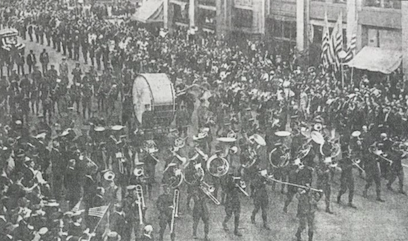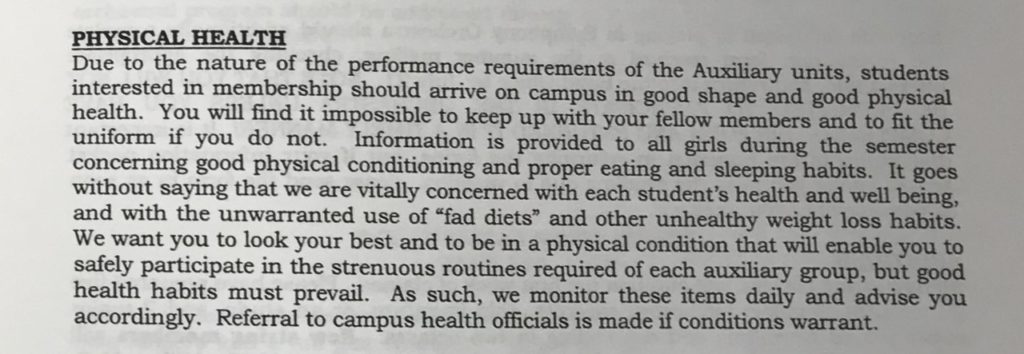Posted on December 10, 2019 by small20
The “All American” Band Becomes Open to All
by Jackie Krutsch
“Every time something good happens to the university, people look to the band to play ‘Hail Purdue.’” [1] Purdue’s band embodies years of tradition, history, and pride for the school. The band started in 1886 with a handful of cadets and has now grown into a band department that encompasses an organization of more than 800 students. [2] These statements shed light on the magnitude of Purdue’s bands, especially the “All American” Marching Band. For a band that has existed for almost 135 years at a university with no school of music, the talent and success of Purdue’s marching band and additional concert bands has grown with each year. Despite this history and esteem, the band has only been open to women joining within the past 65 years, and has only let women play instruments and march during football season within the past 50 years. Once women were allowed to participate in the “All American” Marching Band, they still faced specific restrictions and demands required of them based on their gender.
The “All American” Marching Band got its name from a TV broadcaster who stated that Purdue’s marching band was truly an “All American” band, equipped with their lighted instruments and uniforms that they used during the first halftime show. [3] The Marching Band has a rich history, involving many distinguished alumni and multiple “firsts” that were set over time. Neil Armstrong, the first man on the moon, played baritone at Purdue, Orville Redenbacher, who founded Orville Redenbacher popcorn, played tuba during his time in the band, and Russell Games Slayter, who invented fiberglass, also played tuba. [4] Purdue’s “All American” Marching Band was the “first band to break military ranks to create a formation of any kind” with the iconic Block ‘P,’ it was the “first band to create an oversized bass drum,” and it was the “First Big Ten band to march in the Macy’s Thanksgiving Day Parade,” along with many other firsts. [5] As the prestige of the band rose, so did the number of musicians. Throughout history, during the football season, everyone involved in Purdue Bands plays in the “All American” Marching Band, and during the off-season in the winter and spring, there are other bands that students can get involved in in order to keep their skills sharp. In 1958, “with increased enrollment and interest in the Bands, this year’s band program was expanded into one of the largest in the country. This program was divided among four units, Symphonic, Varsity, Regimental, and Variety. Of course for football season we were all together in the traditional Marching Band, which, this year, was bigger and better than ever.” [6] These additional units, the symphonic, varsity, regimental, and variety bands, have shifted over the band’s history and Purdue Bands and Orchestras currently consists of the athletic bands and auxiliaries, concert bands, jazz bands, orchestras, chamber music, and other ensembles. [7]

Early on in the Band’s history, the students involved were all men except for the “Fair Lady” group of majorettes, who accompanied the all-male band groups, but information regarding the extent of their performances is limited. According to a Bands informational booklet from the 1959-1960 school year, all men and women were encouraged to join the bands by registering for band as they would register for classes, but only male members were allowed to perform as part of the “All American” Marching Band. [8] Then, “during the football season, women in the band rehearse with the Indoor Unit.” [9] Due to this, the exact year that all women were permitted to play in the marching band is unclear since they were allowed to join different parts of the band at different times. In 1954, the first twirling position was created and subsequent positions were formed in the following years, so women played a large role in the auxiliary groups. As of 1967, of the 320 band members, 293 of them were men and the 27 who were women were twirlers. [10] Women also made up half of the flagmen, but flagmen usually consisted of “bass clarinetists, horns, oboes and other instruments not utilized in the block marching band plus women who desire marching experience.” [11] The inclusion of women as flag carriers was not equal to the inclusion of men as flag carriers since men could choose to march in the band or march as flagmen, but women did not have this option of marching in the band. Women’s only opportunities to be a part of the “All American” marching band for many years was as a twirler, majorette, flagsmen, or indoor band performer.

Purdue’s Bands have always had meticulous guidelines in regards to uniform and appearance, and band members receive handbooks each school year that explicitly state these guidelines. The section for auxiliary members in the 2000-2001 handbook stated that “students interested in membership should arrive on campus in good shape and good physical health. You will find it impossible to keep up with your fellow members and to fit the uniform if you do not. Information is provided to all girls during the semester concerning good physical conditioning and proper eating and sleeping habits.” [12] Although these instructions at first appear reasonable in proposing that members be in good physical shape, there were instructions like these written only for the auxiliary groups, which consisted of all women. Nowhere in the rest of the band booklet were there specific directions on how to continue to fit into one’s uniform and have proper eating habits. In addition to these lifestyle tips, the handbooks also include requirements on how to maintain one’s uniform so that each band member looks professional and there is a consistent look to the whole band. There are rules regarding men’s facial hair, including that mustaches must be well trimmed and beards are not allowed. [13] Rules regarding jewelry are also included, noting that jewelry may not be worn, other than wedding/engagement rings and watches, and this goes for both sexes. [14] Restrictions on makeup and nail polish worn are also present for band members, but the make-up type and application, hair style, and hose worm all had to be the correct, precise form as described in the band handbooks. [15] The number of written rules about appearance were more extensive for women than for men as shown by these guidelines. Between the restraints on and requirements for physical appearance, uniform appearance, and overall aesthetic for band and auxiliary members, it is apparent that more of these restraints and requirements were targeted at women participating in the groups. So, not only were women excluded from the participation in the band for close to 100 years, once they were granted permission to join they were held to a standard that was not equal to their male counterparts.
Women’s integration into Purdue’s bands may not have been as “All American” as the marching band’s name proposes, but in the band today, women are appreciated for their participation in the organization and aid in the band’s overall stature. “Whether they graduated a year ago, during World War II, the Depression or before World War I, all band alumni have something in common — and unbridled delight in telling the band tales of their days at ‘Old Purdue.” [16]
[1] Purdue News Service: Purdue Band’s history commemorated, 7 December 1987, Purdue Bands Vertical Files 1980-1989, Purdue Archives and Special Collections, Purdue University Libraries.
[2] Ibid.
[3] History, Purdue University Purdue Bands & Orchestras, https://www.purdue.edu/bands/aboutus/history/.
[4] Ibid.
[5] Ibid.
[6] Purdue All American Band 1958-59 Pamphlet, 1958, Lynne Ann Phillips Scrapbook, Purdue Archives and Special Collections, Purdue University Libraries.
[7] Ensembles, Purdue University Purdue Bands & Orchestras, https://www.purdue.edu/bands/ensembles/.
[8] Purdue University Bands General Information booklet 1959-1960, 1959, Lynne Ann Phillips Scrapbook, Purdue Archives and Special Collections, Purdue University Libraries.
[9] Ibid.
[10] College Bands Strike it Big, Parade Reading Eagle 12, November 1967, Purdue Bands Vertical Files 1960-1969, Purdue Archives and Special Collections, Purdue University Libraries.
[11] Purdue University All American Marching Band Handbook Fall 1992, 1992, UA 160, Purdue University Bands and Orchestras records, Purdue Archives and Special Collections, Purdue University Libraries.
[12] Purdue University Department of University Bands Course Offerings and Information Booklet 2000-2001, 2000, Purdue Bands UA 160, Purdue University Bands and Orchestras records, Purdue Archives and Special Collections, Purdue University Libraries.
[13] Purdue University All American Marching Band Handbook Fall 1992, Purdue Bands UA 160, Purdue University Bands and Orchestras records, Purdue Archives and Special Collections, Purdue University Libraries.
[14] Ibid.
[15] Ibid.
[16] Purdue News Service: Purdue Band’s history commemorated, 7 December 1987, Purdue Bands Vertical Files 1980-1989, Purdue Archives and Special Collections, Purdue University Libraries.